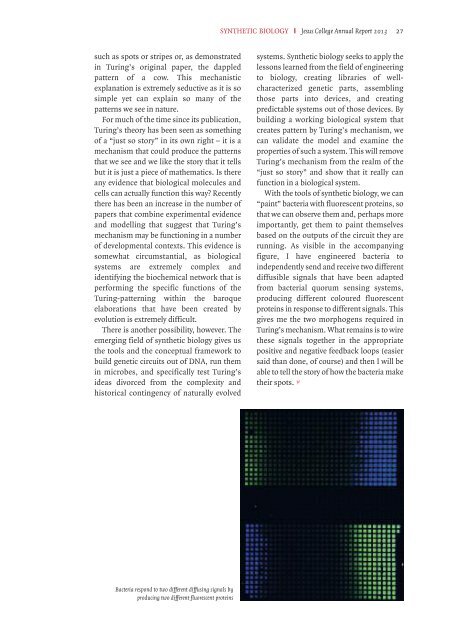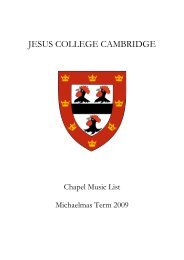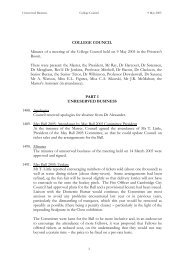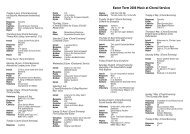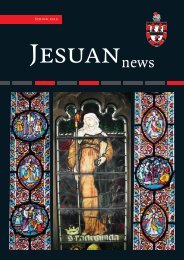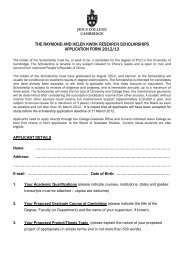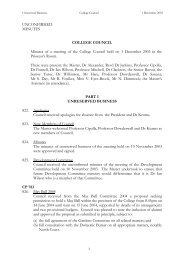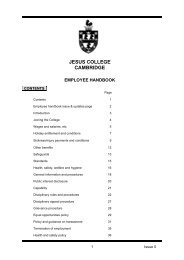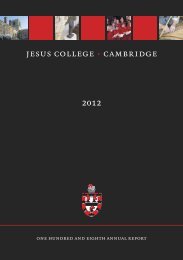2013 Annual Report - Jesus College - University of Cambridge
2013 Annual Report - Jesus College - University of Cambridge
2013 Annual Report - Jesus College - University of Cambridge
You also want an ePaper? Increase the reach of your titles
YUMPU automatically turns print PDFs into web optimized ePapers that Google loves.
SYNTHETIC BIOLOGY I <strong>Jesus</strong> <strong>College</strong> <strong>Annual</strong> <strong>Report</strong> <strong>2013</strong> 27<br />
such as spots or stripes or, as demonstrated<br />
in Turing’s original paper, the dappled<br />
pattern <strong>of</strong> a cow. This mechanistic<br />
explanation is extremely seductive as it is so<br />
simple yet can explain so many <strong>of</strong> the<br />
patterns we see in nature.<br />
For much <strong>of</strong> the time since its publication,<br />
Turing’s theory has been seen as something<br />
<strong>of</strong> a “just so story” in its own right – it is a<br />
mechanism that could produce the patterns<br />
that we see and we like the story that it tells<br />
but it is just a piece <strong>of</strong> mathematics. Is there<br />
any evidence that biological molecules and<br />
cells can actually function this way? Recently<br />
there has been an increase in the number <strong>of</strong><br />
papers that combine experimental evidence<br />
and modelling that suggest that Turing’s<br />
mechanism may be functioning in a number<br />
<strong>of</strong> developmental contexts. This evidence is<br />
somewhat circumstantial, as biological<br />
systems are extremely complex and<br />
identifying the biochemical network that is<br />
performing the specific functions <strong>of</strong> the<br />
Turing-patterning within the baroque<br />
elaborations that have been created by<br />
evolution is extremely difficult.<br />
There is another possibility, however. The<br />
emerging field <strong>of</strong> synthetic biology gives us<br />
the tools and the conceptual framework to<br />
build genetic circuits out <strong>of</strong> DNA, run them<br />
in microbes, and specifically test Turing’s<br />
ideas divorced from the complexity and<br />
historical contingency <strong>of</strong> naturally evolved<br />
systems. Synthetic biology seeks to apply the<br />
lessons learned from the field <strong>of</strong> engineering<br />
to biology, creating libraries <strong>of</strong> wellcharacterized<br />
genetic parts, assembling<br />
those parts into devices, and creating<br />
predictable systems out <strong>of</strong> those devices. By<br />
building a working biological system that<br />
creates pattern by Turing’s mechanism, we<br />
can validate the model and examine the<br />
properties <strong>of</strong> such a system. This will remove<br />
Turing’s mechanism from the realm <strong>of</strong> the<br />
“just so story” and show that it really can<br />
function in a biological system.<br />
With the tools <strong>of</strong> synthetic biology, we can<br />
“paint” bacteria with fluorescent proteins, so<br />
that we can observe them and, perhaps more<br />
importantly, get them to paint themselves<br />
based on the outputs <strong>of</strong> the circuit they are<br />
running. As visible in the accompanying<br />
figure, I have engineered bacteria to<br />
independently send and receive two different<br />
diffusible signals that have been adapted<br />
from bacterial quorum sensing systems,<br />
producing different coloured fluorescent<br />
proteins in response to different signals. This<br />
gives me the two morphogens required in<br />
Turing’s mechanism. What remains is to wire<br />
these signals together in the appropriate<br />
positive and negative feedback loops (easier<br />
said than done, <strong>of</strong> course) and then I will be<br />
able to tell the story <strong>of</strong> how the bacteria make<br />
their spots.<br />
Bacteria respond to two different diffusing signals by<br />
producing two different fluorescent proteins


